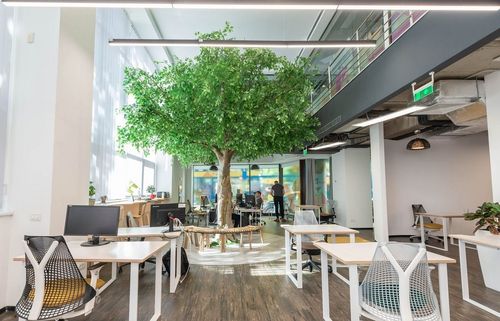

Reorganizarea spaţiilor de lucru în modelul hibrid
08 February, 2024
Distribuie acest articol
Cuprins
Actualul trend accelerat de implementare a modelelor de lucru hibrid aduce liderilor nu doar invitația de a regândi procesele şi raportul timp petrecut la sediu vs. remote, ci şi o provocare de design interior: reorganizarea spaţiilor de birouri.
Ce lăsăm în urmă din vechiul stil de organizare a spaţiului de lucru? Care sunt noile cerinţe de avut în vedere pentru a ne face zilele la birou eficiente şi plăcute?
Ca în toate schimbările presupuse de această tranziţie de amploare, companiile se confruntă cu un exerciţiu de creativitate şi flexibilitate. Întrucât găsirea cele mai potrivite formule hibrid pentru fiecare organizaţie este un experiment ce se ajustează pe parcurs, ne putem aştepta ca şi schimbările în design-ul spaţiilor de lucru să se desfăşoare gradual.
Ce păstrăm din configuraţia anterioară?
Ai luat deja hotărârea de a avea zilnic angajaţi care lucrează remote şi angajaţi prezenţi la birou? Realizezi că în aceste condiţii este mai greu de preconizat cu exactitate câţi oameni vor fi simultan fizic la sediul companiei? De câte spaţii de lucru individuale vei mai avea nevoie? De câte săli de şedinţe? Pentru cât timp?
Dacă în trecut era clar că fiecare angajat are nevoie de un loc doar al lui pentru a-şi desfăşura munca, primul lucru pe care îl constatăm cu ocazia adoptării modelului hibrid este că nu mai avem de ce să blocăm spaţiu în acelaşi timp pentru toată lumea.
Nu ne mai sunt necesare atâtea birouri individuale. În schimb, trebuie să proiectăm spaţii flexibile, atât pentru cei care vin să lucreze în linişte şi separaţi de restul colegilor, cât şi pentru cei care se întâlnesc cu scopul de a lucra în echipă şi de a socializa.
Pentru reorganizarea spaţiilor de lucru hibride, companiile iau în considerare în prezent şi opţiuni legate de suprafaţă: de cât spaţiu mai au cu adevărat nevoie? Se pot restrânge (beneficiind de reducerea costurilor cu chirii) sau preferă să rămână pe vechile poziţii, concentrându-se pe reconfigurarea aceleiaşi suprafeţe?
O altă variantă care câştigă teren în rândul anumitor companii este reducerea și reorganizarea spaţiilor de lucru mari şi crearea de spaţii mai mici sau sateliţi, localizaţi în zone disparate, uşor accesibile angajaţilor care au nevoie să ajungă rapid la birou în zilele non-remote.
Noile destinaţii după reorganizarea spaţiilor de lucru
Cheia unui design adaptat la cerinţele muncii în regim hibrid stă în răspunsul la câteva întrebări strategice:
- În ce scopuri vom mai merge la birou?
- Când este mai eficient să fim prezenţi fizic la birou?
- Care sunt nevoile logistice specifice acestor circumstanţe?
Dacă în trecut mergeam zilnic la birou pentru că doar de acolo ne puteam desfăşura munca în general, în prezent lăsăm în urmă abordările rigide şi ne stabilim scopuri mai clare pentru prezenţa fizică la sediul companiei.
- Aşa cum au sesizat toate organizaţiile aflate în tranziţie spre modele hibrid, este esenţial să privim noile birouri ca spaţii de colaborare. Birourile viitorului facilitează întâlniri de lucru în echipă, sesiuni de brainstorming, interacţiuni care stimulează creativitatea şi întăresc simţul conexiunii cu colegii, un simţ ce se estompează atunci când lucrăm remote pentru mult timp.
- O problemă semnalată de majoritatea organizaţiilor în timpul pandemiei este integrarea mai anevoioasă a oamenilor noi în echipă atunci când se munceşte fully-remote. Deşi între timp au fost dezvoltate metode eficiente de onboarding de la distanţă, reorganizarea spaţiilor de lucru în companiile hibrid poate pune accent pe zone de mentorat, învăţare şi training faţă în faţă, un avantaj faţă de lucrul exclusiv remote.
Cum arată un birou al viitorului?
- În noile condiţii, trebuie avută în vedere ideea de adaptabilitate a spaţiilor de birouri pentru utilizare alternativă. De la utilizarea, prin rotaţie, a aceluiaşi birou cu alţi colegi la mobilă modulară (care poate fi uşor asamblată şi reasamblată în funcţie de nevoi), spaţiile hibrid lasă în urmă design-ul inflexibil.
- În proiectarea unui astfel de spaţiu, se pune mult accent pe dotarea corespunzătoare a sălilor de videoconferinţă. Se impune ca acestea să dispună de instrumente care permit colaborarea optimă între cei prezenţi fizic la şedinţă şi colegii remote. Echipa Computer Weekly menţionează importanţa sonorizării şi a proiectoarelor de calitate în sălile de conferinţă, posibilitatea de a oferi subtitrări şi transcrieri ale discuţiilor în timp real, cea de a-i apela rapid pe cei cooptaţi telefonic/video în discuţii spontane. În felul acesta, participanţii de la birou şi cei remote se pot simţi implicaţi în mod egal în atmosfera de lucru.
- O facilitate foarte utilă care vine în întâmpinarea spaţiilor hibrid este posibilitatea de a-ţi rezerva un spaţiu prin intermediul aplicaţiilor dedicate. Te asiguri astfel că în zilele când ai nevoie să fii prezent fizic la sediul firmei vei avea locul potrivit, indiferent câţi colegi vor mai fi în jur.
- Nu în ultimul rând, dotările multiuncţionale ale spaţiilor hibrid ajută şi la configurarea rapidă a unor zone informale, astfel încât zilele petrecute la birou să permită pauze de socializare plăcute şi motivante.
Fără îndoială, indiferent de formula aleasă, liderii din prezent au ocazia să implementeze odată cu modelele hibrid şi un management mai bun al spaţiilor de lucru.
Ţie în ce fel de birou ţi-ar plăcea să lucrezi?
Rămâi la curent cu cele mai recente articole, evenimente și tot ce Pluria are de oferit
Prin abonarea la newsletter, ești de acord cu politica noastră de confidențialitate

În ritmul tot mai solicitant al vieții moderne, stresul cronic a devenit unul dintre cei mai nocivi factori care afectează societatea la scară largă.
În fața acestei provocӑri, avem două opțiun[...]
08 February, 2024

Conceptul de coworking, așa cum îl cunoaștem astăzi, este unul recent, care însă a evoluat într-un ritm accelerat și continuă să o facă. Aceasta înseamnă că ne numărăm printre cei ce scriu în prezen[...]
08 February, 2024

Indiferent câți ani au trecut de la ultima acreditare pe care ai obținut-o în meseria ta și de experiența acumulată între timp, evoluția profesională este un proces bazat pe învățare continuă.
[...]
08 February, 2024